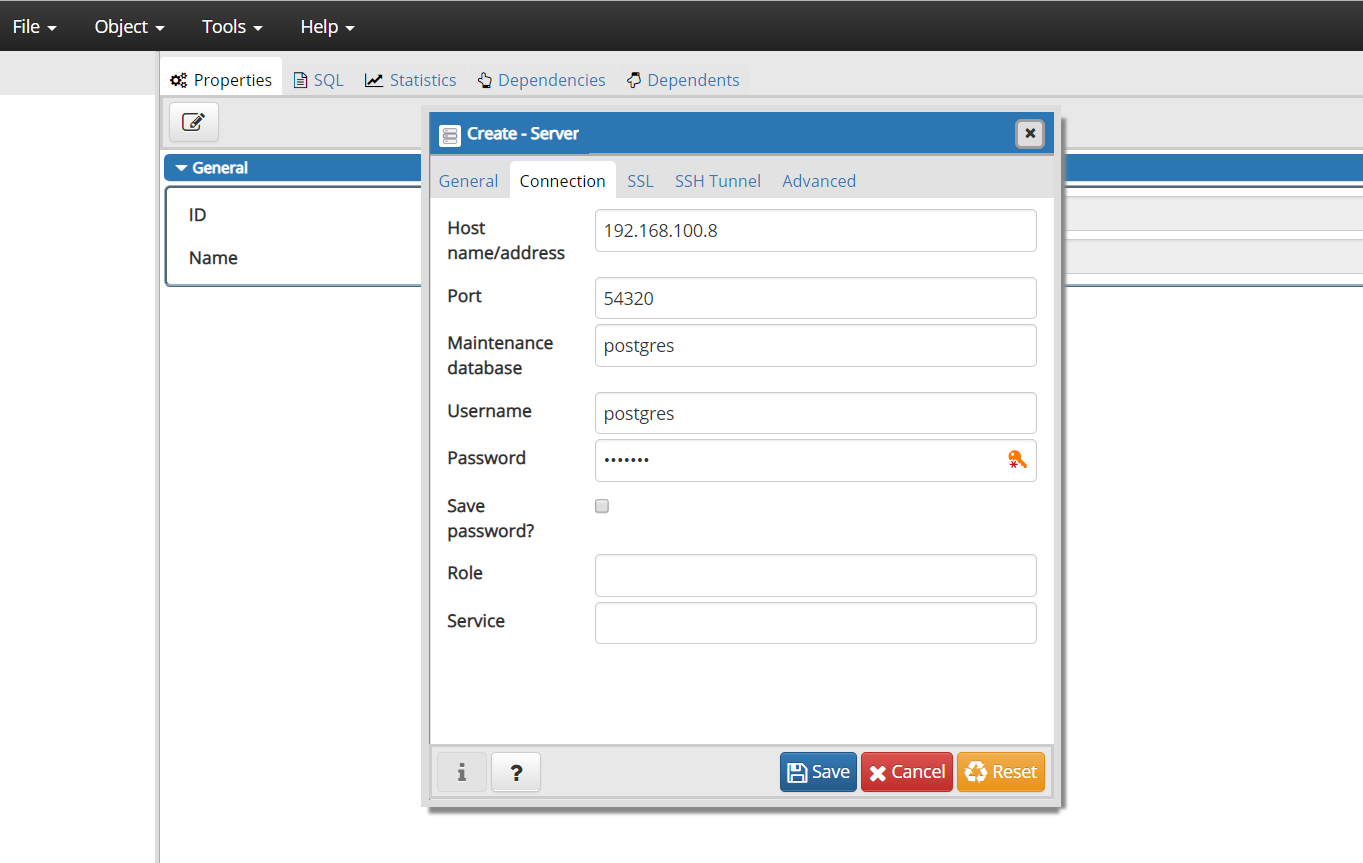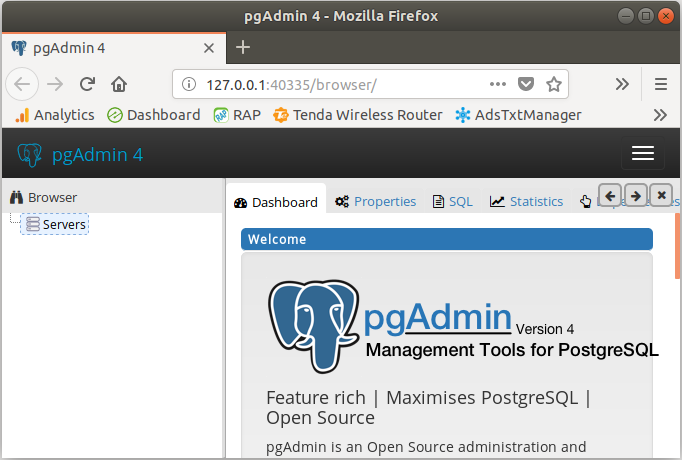There are two main ways to install PostgreSQL on mac OS X.
The pages in this section give additional details about each binary package available as well as more direct download links. In addition, you can download source tarballs and pgAgent for your servers to enable additional functionality. PgAdmin 4 is a complete rewrite of pgAdmin, built using Python and Javascript/jQuery. PgAdmin - PostgreSQL Tools for Windows, Mac, Linux and the Web. The pages in this section give additional details about each binary package available as well as more direct download links. In addition, you can download source tarballs and pgAgent for your servers to enable additional functionality. PgAdmin 4 is a complete rewrite of pgAdmin, built using Python and Javascript/jQuery. Aug 14, 2019 In this how-to we’ll be focused on getting up and running on a Mac, although PGAdmin supports all the popular operating environments. Installing PGAdmin. To get the latest version, check out the PGAdmin download page. Once you have downloaded, installed and opened up the PGAdmin application, you’ll need to set a master password for the.
PostgreSQL and pgAdmin installation on Mac, #PostgreSQL,#pgAdmin, #SQL #installation Beginners class in sql using Postgresql Database Download Links Postgre. Postgres is a powerful and free object-relational database management system. Download the installer certified by EDB for all supported PostgreSQL versions. This installer includes the PostgreSQL server, pgAdmin; a graphical tool for managing and developing your databases, and StackBuilder; a package manager that can be used to download and install additional PostgreSQL tools and drivers.
- Downloading the app file from postgresapp.com.
Using Homebrew
Homebrew can be installed by running the following command in a terminal:
/usr/bin/ruby -e '$(curl -fsSL https://raw.githubusercontent.com/Homebrew/install/master/install)'
If Homebrew is already installed, make sure that it is up to date by running:
brew update
Then ensure there are no conflicts or errors using:
brew doctor
Homebrew is a powerful package manager with many uses, including installing and running postgreSQL. This can be done by typing the following command into a terminal:
Now that postgres is installed the default server can be started by running the command:
This will start up a postgres server hosted locally on port 5432. The server will be run out of the directory /usr/local/var/postgres.
It can now be accessed by typing the following command:
This will connect to the server and access the postgres database. Once this is done:
- Schemas and tables can be created
- Data can be loaded and deleted from the database
- Queries can be run
The process should look like this:
This shows that the server has been started and can be connected to.
(Optional) Creating a Custom Data Directory
A custom data directory can also be used for a server. To do this, first create a directory to be used as the server location. For example, create a directory called myData in the home directory:
Once the directory is created, the server can be initialized. This means that we configure the directory and add the necessary files to run the server. To do this run the initdb command as shown:
This will fill the myData directory with files necessary to run the server:
Now that the server is initialized and the log file is created, you can start the server from this directory. To do this use the command and substitute in for the specified values:

The “Data Directory” refers to the directory that was just initialized (in this case myData). The “Log file” is a file that will record server events for later analysis. Generally log files are formatted to contain the date in the file name (e.g. “2018-05-27.log” or “myData-logfile-2018-05-27.log”) and should be stored outside of the database that they are logging so as to avoid unnecessary risks. Log files can be dense to read but are very useful for security and debugging purposes:
The command above will generate a log file like the one shown, start the server, and tie the log file to the server. If a log file is not specified, events will be logged to the terminal:
The server will only start if the port is free. If the default server is running it must first be stopped using the pg_ctl -D /usr/local/var/postgres stop command:
Once started, it can be connected to the same way as before using:
Using PostgreSQL App
To run a server through the postgres app, the first step is to download the program. The app can be downloaded on postgresapp.com. Once the app is downloaded and moved into the applications folder, the app can be opened.
Open the Postgres app:
In order to start the server, click the start button.
This will start the server. Details on the server can be found by opening the server settings:
This interface shows all the essential information regarding the server. It also allows the port to be changed very easily. This is useful because multiple PostgreSQL servers can
Note: To change the port in the terminal, the ‘postgres.conf’ file (which can be found in the data directory) must be edited. This looks like the following:
Using Terminal with the PostgreSQL App
Once the app has been downloaded, command line tools can be used as well. These tools can be accessed by typing:
For example, the ‘postgres’ database on the server can be connected to using the psql tool with postgres as an argument:
Rather than typing out the full path each time however, the path can be added to a file that will allow significantly easier access to the tools, allowing the tools be accessed from any directory on the computer. To do this, the following command can be run in the terminal:

Once this is done, the ‘postgres’ database can be accessed by simply typing:
Summary
- Homebrew:
- Download/update Homebrew
- Use Homebrew to install postgres
- (Optional) Create New Data Directory
initdb
- Start Server
- App:
- Download app and move to Applications
- Run App
- (Optional) Set different port for multiple servers
- Start Server
- (Optional) Add path so that command line tools are easy to access
References
Written by: Matthew Layne
Reviewed by: Blake Barnhill , Matt David
PostgreSQL Downloads
PostgreSQL is available for download as ready-to-use packages or installers forvarious platforms, as well as a source code archive if you want to build ityourself.
Packages and Installers
Select your operating system family:
LinuxmacOS
Windows
Solaris
 BSD
BSD
Select your Linux distribution:
DebianPgadmin 4 Download Windows
Red Hat/CentOS
SUSE
Ubuntu
Pgadmin Download Mac Latest
Other Linux
Select your BSD operating system:
OpenBSDDownload Linux
Install Pgadmin Mac
FreeBSDNetBSD
Source code
The source code can be found in the main file browseror you can access the source control repository directlyat git.postgresql.org.Instructions for building from source can be found in thedocumentation.
Beta/RC Releases and development snapshots (unstable)
There are source code and binary packagesof beta and release candidates, and of the current development code availablefor testing and evaluation of new features. Note that these builds shouldbe used for testing purposes only, and not for production systems.
3rd party distributions
Machine Learning and Data Visualization with PostgreSQL
Download 2UDA for Windows, macOS, and Linux - certified by 2ndQuadrant for all supported versions of PostgreSQL.
2ndQuadrant Unified Data Analytics (2UDA) is a data analytics application suite that unifies databases, machine learning, data mining, and visualization. The application can be installed using a user-friendly, one-click desktop installer. 2UDA builds on the capabilities of Orange, an open source machine learning and data visualization tool, by integrating it with the PostgreSQL database.
Ready to run stacks
'LAPP', 'MAPP' and 'WAPP' (Linux/Mac/Windows + Apache + PHP + PostgreSQL)stacks are available fromBitNami.
Additional Software
Software Catalogue
There is much software available that is not bundled with PostgreSQL. The SoftwareCatalogue offers a listing of many commercial and Open Source applications, interfaces and extensions to PostgreSQLthat you may find useful.

If you wish to have your product listed in the catalogue, please fill out this form.
File Browser
Download Pgadmin For Windows 10
Pgadmin 3 For Windows
You can download most of the software we publish from a mirror site using our File Browser.